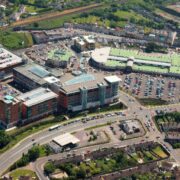John Cradden examines ways farms and other agribusinesses can make their land and operations more sustainable.
Whether you see it as an opportunity or a burden, making your farm business more sustainable is an important step towards securing its long-term future and profitability.
Given that agriculture is currently responsible for around 38% of Ireland’s greenhouse gas (GHG) emissions, according to the EPA, the government has set the target for the sector to reduce these emissions by 25% by 2030.
“In simple terms, farming is different to other businesses in that it is about changing how a farmer farms”
There are a number of ways this can be achieved, but the focus is on enhancing and improving water quality, biodiversity and animal welfare. This includes such steps as promoting reforestation, cutting back on the use of nitrogen fertiliser in favour of organic alternatives, the use of regenerative food practices (eg crop rotations), tackling food waste and adopting new technologies such as solar power and anaerobic digestion to reduce carbon footprints.
The sector has already seen a significant effect on GHG emissions by a move away from the use of synthetic fertiliser (ie nitrogen, phosphorous and potassium), for instance. Emissions fell by 4.6% in 2023 as a result of a 18% reduction in the use of these types of fertiliser.
“In simple terms, farming is different to other businesses in that it is about changing how a farmer farms. For example, the type of grass that’s grown, the type of fertiliser that is used or how hedgerows are managed on the farm,” said Eoin Lowry, head of Agri Sector at Bank of Ireland.
So what are the steps your agribusiness needs to take to reduce its carbon footprint and put in place a more sustainable production system, and what are the supports available?
Origin Green
A good first port of call is Origin Green, a food and drink sustainability programme run by Bord Bia. It provides on-farm sustainability assessments that look at greenhouse gas emissions, biodiversity, water use, energy efficiency, soil management and socio-economic factors.
From these assessments, a ‘Farmer Feedback Report’ is produced that provides farmers with practical guidance and advice on how to become more sustainable in every aspect of their businesses and, in time, be able to use the Origin Green logo, which signals to customers, suppliers and other business partners that your agribusiness has met its sustainability production standards.
Teagasc MACC
Another key agriculture sustainability programme is Teagasc’s MACC (Marginal Abatement Cost Curve), which identifies the most cost-effective pathways for farms to reduce their GHG emissions and enhance carbon sequestration.
Now in its third iteration, it focuses on the adoption of new technologies to achieve sustainability targets, and features a number of scenarios (facilitated by a tech platform called AgNav) that will help farmers figure out what route they can take to achieving these targets.
Follow the carbon farming framework
You may have heard the term ‘carbon farming’, which is defined by the European Commission as a green business model that rewards farmers for using “improved land management practices resulting in the increase of carbon sequestration in living biomass, dead organic matter, and soils by enhancing carbon capture and/or reducing the release of carbon into the atmosphere, in respect of ecological principles”.
Through the LIFE Carbon Farming Project, which operates in six EU countries and 50 partners (including Teagasc in Ireland), farmers will be able to access funding and financing mechanisms to support this work.
The Irish framework for the project, developed by the Department of Agriculture, Food and the Marine and EIT Climate-KIC, is expected to be published by 2024, and will be followed by a large-scale pilot aiming for at least 5,000 farms of various sizes between the end of 2024 and 2027, depending on funding.
Financing
Farmers can access finance for more sustainable farming through schemes like Bank of Ireland’s Enviroflex, which provides discounted loans of up to €500,000 (and up to €125,000 for unsecured loans) for up to seven years or more. These can be used to fund any type of investment that improves farm sustainability like improved farm buildings, new milking facilities, enhanced animal housing and farm road development.
It can also be used to finance new farm machinery, renewable energy projects, sustainability enhancing measures like forestry and tree planting, biodiversity schemes and ACRES projects.
To qualify, farms must be part of a sustainability scheme with their partner processor or co-op that is following frameworks underpinned by Teagasc MACC and Bord Bia’s Origin Green Programme.
“Bank of Ireland is ready to support its farming customers to embrace these changes in the knowledge that much of what is being asked of them will, in the first instance, enhance the environmental sustainability of the farm but can also contribute to improving overall farm profitability,” said Lowry.
Consider also looking for specific supports from the SEAI for farms, such as solar PV panels under the TAMS (Targeted Agricultural Modernisation Scheme, and the SEAI Non-domestic Microgen Grant.
Enterprise Ireland is also open to supporting agritech projects that are geared towards addressing climate and sustainability issues.
-
Bank of Ireland is welcoming new customers every day – funding investments, working capital and expansions across multiple sectors. To learn more, click here
-
Listen to the ThinkBusiness Podcast for business insights and inspiration. All episodes are here. You can also listen to the Podcast on:
-
Apple
-
Spotify
-
SoundCloud





